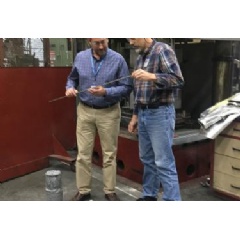U.S. Department of Energy Awards GE $33.7 Million to Strengthen the Resilience of Nuclear Reactor Fuel
- GE’s Global Research Center and Nuclear fuel business partnering with three National Labs (Los Alamos, Oak Ridge and Idaho) and with the Exelon and Southern Company utilities to develop and test more advanced fuel rod technologies
- Project will tap Global Research’s deep technical strength in materials science, 3D printing and jet engine technologies to develop new IronClad material for fuel rods and related components that are more tolerant of extreme conditions.
- Will accelerate six-years of ongoing research and development by GE, National Labs and the Department of Energy to deliver more advanced solutions
GE today announced it has been awarded a $33.7 million project from the U.S. Department of Energy to continue development of advanced fuel rod technologies that are more robust and have improved performance during normal and accident conditions. The key goal over the two-and-a-half-year project is to develop and demonstrate new fuel rods that could be commercially deployed and set new standards in plant safety.
The project will be led by an interdisciplinary team of scientists and engineers from GE’s Global Research Center in Niskayuna, NY, which has been working with Global Nuclear Fuel, a GE-led joint venture, National Labs and the Department of Energy on IronClad, an alternative material solution for fuel rods that is more durable to extreme conditions.
“Today, nuclear plants already set the highest bar for safety, durability and reliability,” said Evan Dolley, Technical Operations Leader in Metals, GE Global Research. “Our project aims to raise the bar even higher by developing alternative fuel rods that are even more resistant and could endure the loss of active cooling in a reactor core much longer than current fuel.”
The DOE’s Office of Nuclear Energy has been a leader in supporting the development of safer technologies. GE and other industry stakeholders have worked closely with the Department and made great progress to drive new advancements. One of those advancements was GE’s alternative IronClad material for the fuel rods, which has higher durability tolerances than the current state-of-the-art Zircaloy metal used to make fuel rods today. It is anticipated the new fuel rods being designed by GE scientists will provide enhanced fuel reliability, increased safety, operational flexibility and reduced cost by leveraging accident tolerant properties, withstanding extreme conditions for longer periods of time.
Dolley said, “With the DOE’s support and in partnership with our National Lab and utility partners, we have an extraordinary opportunity to accelerate our ongoing fuel rod work and ultimately deliver new technologies to market that benefit our U.S. nuclear facilities and those globally.”
“We look forward to continuing to work with the GE Global Research team, customers and partners to pave the way for deployment of our IronClad and ARMOR advanced fuel solutions in reload quantities,” said Amir Vexler, CEO of GNF.
According to the World Nuclear Association, nuclear energy accounts for 11% of the world’s energy from 450 nuclear reactors. It makes up 20% of energy in the U.S. In France, nuclear comprises 72% of their energy mix.
Key Project Details
In addition to developing an alternative metal material for the fuel rods, Dolley said the project team also is pulling unique technical expertise from its Aviation and Additive businesses. Ceramic matrix composites (CMCs), which today are high temperature materials used in commercial jet engines to improve efficiency and performance, are being applied to develop the channel boxes that surround the fuel rods. The project also will deploy additional test fuel rods of GNF’s ARMOR coated cladding solution in the same reactor as the Ironclad test segments.
The project team also is developing additive technologies to be used to quickly fabricate 3D metal end caps for prototyping the fuel rod designs.
Dolley explained, “With the integration of nuclear-grade CMCs, we can exploit the higher heat properties of ceramics to build an even more resilient system. And the use of additive is designed to enable a more rapid response if spare parts are needed for other reactor components.
The further development of the fuel rod and related components will be done in partnership with the Los Alamos, Oak Ridge and Idaho National Labs. Global Nuclear Fuels, Exelon and Southern Nuclear are conducting field studies with more planned in the future.
About GE Global Research
GE Global Research is GE’s innovation powerhouse where research meets reality. We are a world-class team of 1,000+ scientific, engineering and marketing minds (600+ Ph. Ds), working at the intersection of physics and markets, physical and digital technologies, and across a broad set of industries to deliver world-changing innovations and capabilities for our customers.
( Press Release Image: https://photos.webwire.com/prmedia/6/230532/230532-1.jpg )
WebWireID230532
This news content was configured by WebWire editorial staff. Linking is permitted.
News Release Distribution and Press Release Distribution Services Provided by WebWire.
